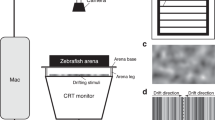Abstract
Due to the highly conserved genetics across the central nervous system, the easily probed visual system can act as an endophenotype for assessing neurological function. Here, we describe a psychophysics approach to assess visually driven swimming behavior in the high-throughput zebrafish genetic model system. We use the optomotor response test together with general locomotion behavior to assess neural processing while excluding motor defects related to muscle function.
Access this chapter
Tax calculation will be finalised at checkout
Purchases are for personal use only
Similar content being viewed by others
References
Curpan AS, Balmus IM, Dobrin RP et al (2022) A mini-review regarding the modalities to study neurodevelopmental disorders-like impairments in zebrafish-focussing on neurobehavioural and psychological responses. Brain Sci 12(9). https://doi.org/10.3390/brainsci12091147
Bilotta J, Saszik S (2001) The zebrafish as a model visual system. Int J Dev Neurosci 19(7):621–629. https://doi.org/10.1016/s0736-5748(01)00050-8
Chhetri J, Jacobson G, Gueven N (2014) Zebrafish--on the move towards ophthalmological research. Eye (Lond) 28(4):367–380. https://doi.org/10.1038/eye.2014.19
Gestri G, Link BA, Neuhauss SC (2012) The visual system of zebrafish and its use to model human ocular diseases. Dev Neurobiol 72(3):302–327. https://doi.org/10.1002/dneu.20919
Easter SS Jr, Malicki JJ (2002) The zebrafish eye: developmental and genetic analysis. Results Probl Cell Differ 40:346–370. https://doi.org/10.1007/978-3-540-46041-1_17
Xie J, Jusuf PR, Bui BV et al (2019) Experience-dependent development of visual sensitivity in larval zebrafish. Sci Rep 9(1):18931. https://doi.org/10.1038/s41598-019-54958-6
Orger MB, Gahtan E, Muto A et al (2004) Behavioral screening assays in zebrafish. Methods Cell Biol 77:53–68. https://doi.org/10.1016/s0091-679x(04)77003-x
Sztal TE, Ruparelia AA, Williams C et al (2016) Using touch-evoked response and locomotion assays to assess muscle performance and function in zebrafish. J Vis Exp 116. https://doi.org/10.3791/54431
Neuhauss SC (2003) Behavioral genetic approaches to visual system development and function in zebrafish. J Neurobiol 54(1):148–160. https://doi.org/10.1002/neu.10165
Neuhauss SC, Biehlmaier O, Seeliger MW et al (1999) Genetic disorders of vision revealed by a behavioral screen of 400 essential loci in zebrafish. J Neurosci 19(19):8603–8615. https://doi.org/10.1523/JNEUROSCI.19-19-08603.1999
Mario K, David B, Denis P et al (2007) What’s new in Psychtoolbox-3. Perception 36(14):1–1
Bizrah M, Dakin SC, Guo L et al (2014) A semi-automated technique for labeling and counting of apoptosing retinal cells. BMC Bioinf 15(1):1–12
Lu Z-L, Dosher B (2013) Visual psychophysics: from laboratory to theory. MIT Press
D'AGOSTINO R, Pearson ES (1973) Tests for departure from normality. Empirical results for the distributions of b 2 and√ b. Biometrika 60(3):613–622
Dunn TW, Fitzgerald JE (2020) Correcting for physical distortions in visual stimuli improves reproducibility in zebrafish neuroscience. eLife 9:e53684. https://doi.org/10.7554/eLife.53684
Creton R (2009) Automated analysis of behavior in zebrafish larvae. Behav Brain Res 203(1):127–136. https://doi.org/10.1016/j.bbr.2009.04.030
Author information
Authors and Affiliations
Corresponding author
Editor information
Editors and Affiliations
Rights and permissions
Copyright information
© 2024 The Author(s), under exclusive license to Springer Science+Business Media, LLC, part of Springer Nature
About this protocol
Cite this protocol
Xie, J., Goodbourn, P., Sztal, T., Jusuf, P.R. (2024). Neural Endophenotype Assessment in Zebrafish Larvae Using Optomotor and ZebraBox Locomotion Assessment. In: Dworkin, S. (eds) Neurobiology. Methods in Molecular Biology, vol 2746. Humana, New York, NY. https://doi.org/10.1007/978-1-0716-3585-8_17
Download citation
DOI: https://doi.org/10.1007/978-1-0716-3585-8_17
Published:
Publisher Name: Humana, New York, NY
Print ISBN: 978-1-0716-3584-1
Online ISBN: 978-1-0716-3585-8
eBook Packages: Springer Protocols




